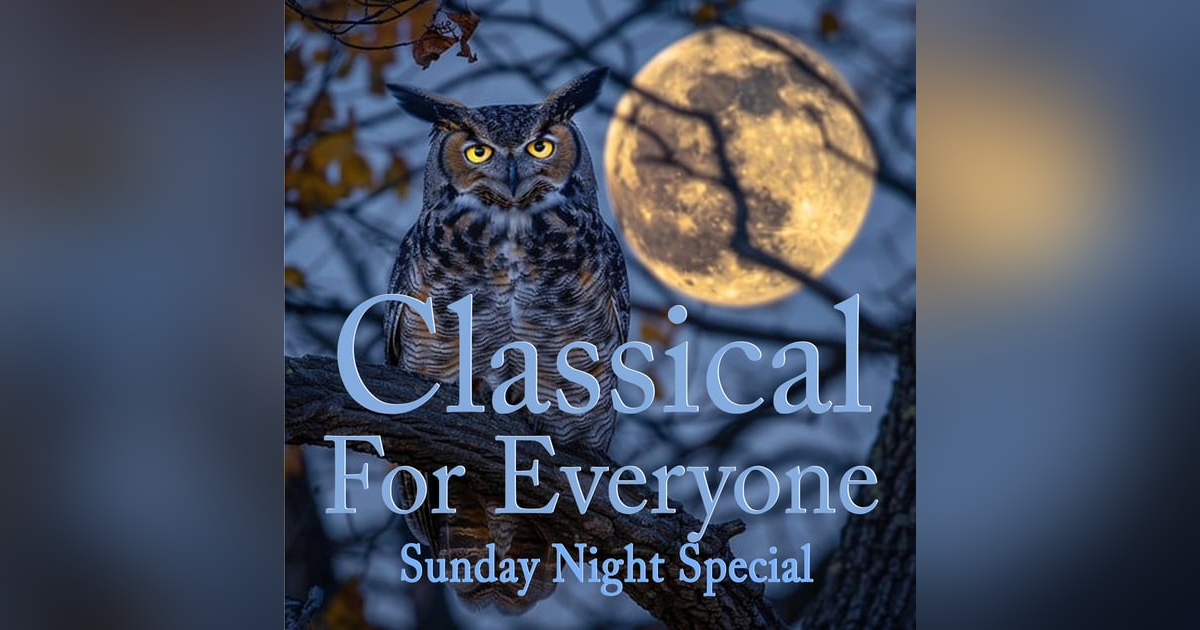Sunday Night Special 4… Aaron Copland’s Third Symphony

The name comes from the night of the week when for some of us, the demon of insomnia hits the hardest… and because my preferred antidote is getting lost in some music. Of course this series is for everyone… but it is perhaps intended a little more for those of you whose sleep has been troubled. The idea of the special is to play just one piece, uninterrupted and in its entirety… with a few minutes of background explained at the end of the episode. This week… Aaron Copland’s Third Symphony from 1946. Performed by the New York Philharmonic conducted by Leonard Bernstein.
Hello Everyone, my name is Peter Cudlipp. Welcome to another in the occasional series of extra episodes of the Classical For Everyone podcast. Episodes which I am calling Sunday Night Specials.
The name comes from the night of the week when for some of us, the demon of insomnia hits the hardest… and for me, and I hope for you, getting lost in some music is a much better thing to do than stare at the ceiling or at a phone screen.
Now I’m not choosing the music with the hope that it will send you to sleep, though it’s fine if it does… this is music to keep you company. And course this series is for everyone… but it is perhaps intended a little more for those of you whose sleep has been troubled.
The idea of the special is to play you just one piece, uninterrupted and in its entirety… with a few minutes of background explained at the end of the episode… if you’re interested. But the main thing is to get straight into the music.
Here now is the American Composer Aaron Copland’s 3rd Symphony completed in 1946. It is in four parts and is about 45 minutes long. Here is the New York Philharmonic Orchestra conducted by Leonard Bernstein.
A
I hope you enjoyed that performance of Aaron Copland’s 3rd Symphony. That performance was by the New York Philharmonic Orchestra conducted by Leonard Bernstein. And now here are a few minutes of background for you. And I have to thank my AI pal Claude for the legwork that I am basing this on.
Aaron Copland was born in Brooklyn, New York, in 1900 to Lithuanian Jewish immigrant parents. He showed early musical talent and began serious composition studies as a teenager. In 1921, he went to Paris to study with the renowned teacher Nadia Boulanger, becoming her first full-time American student.
During his three years in Paris, Copland absorbed modernist techniques and was exposed to Stravinsky, jazz, and the avant-garde. When he returned to America in 1924, his early works were angular, dissonant, and decidedly modernist - pieces like the Piano Variations (1930) and the Short Symphony (1933) were challenging and cerebral, appealing primarily to other composers and new music advocates rather than general audiences.
But by the mid-1930s, during the Great Depression, Copland became increasingly concerned that modern composers had alienated themselves from the public. He consciously sought to write music that could reach a broader audience without sacrificing artistic integrity. This led to his "populist" period, which produced his most famous works: the ballets Billy the Kid (1938), Rodeo (1942), and Appalachian Spring (1944), along with works like Fanfare for the Common Man (1942). These pieces drew on American folk melodies, hymn tunes, and cowboy songs, creating what became recognized as a distinctively "American" sound - open harmonies, wide intervals, and a sense of spaciousness that evoked American landscapes.
Copland composed his Third Symphony between 1944 and 1946, during the final years of World War II and its immediate aftermath. The work represents Copland at the height of his powers and popularity. The symphony is expansive and ambitious - his longest orchestral work - and incorporates his already-famous Fanfare for the Common Man (originally composed in 1942) into the triumphant finale. Copland intended the work as a wartime symphony that would capture the American spirit, though he resisted attaching specific programmatic meanings to it, saying he wanted to write a symphony "that would be accessible to the American public."
The premiere took place on October 18, 1946, with Serge Koussevitzky (whose foundation had commissioned the work) conducting the Boston Symphony Orchestra, and it was an immediate success. Critics hailed it as a major American symphonic achievement, with some calling it the greatest American symphony yet written. Despite this initial success, the Third Symphony's place in the repertoire has been somewhat complicated. While it remains Copland's most significant purely orchestral work and is regularly programmed by major orchestras, it hasn't achieved the ubiquity of his ballet scores. Some have found the work's optimistic Americana too tied to its specific postwar moment, while others consider it somewhat sprawling compared to Copland's more focused works. Nevertheless, it has maintained respect as a major 20th-century American symphony, and it stands as perhaps the fullest expression of Copland's "accessible" period - grand, affirmative, and unapologetic.
My name is Peter Cudlipp and I hope you enjoyed this Sunday Night Special of the ‘Classical For Everyone’ podcast. There will be a regular episode in the next few days and another Sunday Night Special in perhaps a few weeks. Thanks for listening.